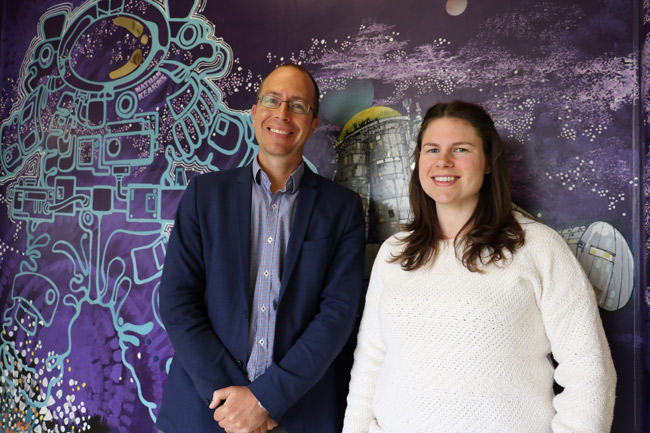
University of Otago Paediatric Endocrinologist Ben Wheeler and Postdoctoral Research Fellow Sara Boucher aim to find out in a new study whether new technology can help teenagers struggling to control diabetes.
Otago Paediatric Endocrinologist Ben Wheeler has secured a $106,000 research grant to undertake a world-first trial to assess teenage diabetics' use of new glucose monitoring technology.
The funding from Cure Kids, a funder of high-impact medical research, is a big boost to enable Associate Professor Wheeler and his team to move forward with the randomised controlled trial.
“There are more than 2,500 children under 18 in New Zealand living with type 1 diabetes and their wellbeing is of ongoing concern,” Associate Professor Wheeler explains.
“We're hopeful this innovation will help them better manage their condition, see improved glycaemic control, increase glucose monitoring behaviour, and improve their quality of life.”
Postdoctoral Research Fellow Dr Sara Boucher is leading the study, under Associate Professor Wheeler's guidance. They will monitor teenagers' use of the new glucose monitoring system which does away with the need for the finger-prick blood test.
The glucose monitoring system works by inserting a thin, hair-like sensor under the skin which remains there for two weeks. A small sensor, which is the size of two stacked $2 coins, is attached to the back of the upper arm and glucose levels are obtained on-demand by scanning a small hand-held “reader” over the arm sensor.
"Of all the new technologies we've had over the past 20 to 30 years, while many have offered benefits, very few have decreased the burden of the illness. This device does promise a reduction in that burden."
The sensor measures glucose levels every minute and provides an average and trend every 15 minutes. Dr Boucher explains the scanner provides information which shows how food, activity and insulin affect glucose levels day and night.
The technology has been around for several years but was only approved for use by New Zealand's medicines and medical devices safety authority, Medsafe, in March, for children aged four to 18 years old with type 1 diabetes.
The University of Otago study will focus on 64 teenagers aged 13 to 18, with poorly-controlled type 1 diabetes. Associate Professor Wheeler explains that while studies have been carried out on young people using the technology internationally, it is the first time adolescents of this specific age with poorly-controlled diabetes will be followed.
“We're aiming to find out how the use of continuous glucose monitoring in a real-world setting can help people who are struggling with their diabetes.”
Teenagers with poorly-controlled diabetes from throughout the South Island and lower North Island are being recruited for the study. Half will use the new technology, while the other half will use the traditional finger-prick test over a six-month period.
Currently, the technology costs $95 a fortnight for the sensors and a one-off cost of $95 for the scanning device. Associate Professor Wheeler is concerned the cost rules use of the technology out for some teenagers and hopes findings from the research will be able to be used to encourage the Government's pharmaceutical funding agency, Pharmac, to subsidise the product.
If the study's results prove the hypothesis of improving glycaemic control and glycaemic monitoring behaviour in teenagers correct, Associate Professor Wheeler believes the new technology will play a big part in improving quality of life for young diabetics.
“Of all the new technologies we've had over the past 20 to 30 years, while many have offered benefits, very few have decreased the burden of the illness. This device does promise a reduction in that burden.”
